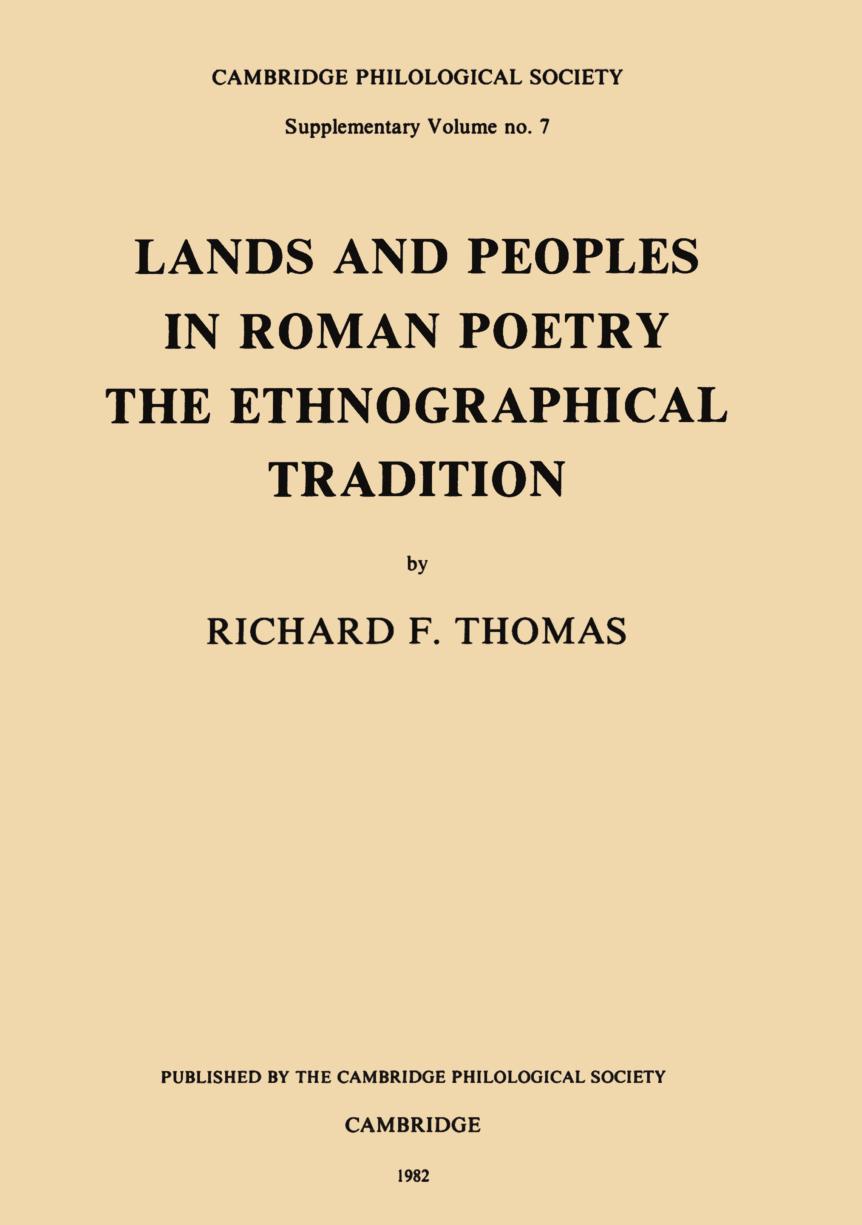Lands and Peoples in Roman Poetry by Richard F. Thomas;

Author:Richard F. Thomas;
Language: eng
Format: epub, pdf
Tags: -
Publisher: Casemate Publishers & Book Distributors, LLC
primum secundum villam potissimum, ubi non resonant imagines (hic enim sonus harum fugae existimatur esse protelum), esse oportet aere temperato, neque aestate fervido neque hieme non aprico, ut spectet potissimum ad hibernos ortus, qui prope se loca habeat ea, ubi pabulum sit frequens et aqua pura, si pabulum naturale non est, ea oportet dominum serere, quae maxima secuntur apes.
(res rust. 3.16.12-13)
Situs, climatic conditions and food-supply are all covered. The terminology, moreover, is that which appears in ethnography (cf. aere temperato; ut spectet potissimum ad hibernos ortus). The seeds, then, of an ethnographical treatment are already in the technical tradition.10 It seems plausible that Virgil, who certainly read Varroâs treatise, could have seen in this account the potential for a fully developed ethnographical description, which would balance the briefer versions elsewhere in the poem.
In fact, Varroâs entire section on the bees already contains the basis for much of Virgilâs material. Again applying Dahlmannâs topoi we can see the treatment of environment (ÏεÏὶ Ïá½¹ÏÏν) in Varroâs account (3.16.12, 15, 23). Also present are: Îµá¼¶Î´Î¿Ï and á¼°ÏÏá½»Ï (3.16.18, 19), á½ÏλιÏÎ¹Ï and ÏÏá½¹ÏÎ¿Ï Ïá¿Ï μάÏÎ·Ï (3.16.7, 9, 30), organization of res domesticae (3.16.4), praedivinatio (3.16.37), and, finally, on kings and rulers (3.16.6, 8, 18). That is, the only categories which have no counterpart in Varroâs version are the Ïá½¹ÏÎ¿Ï ÏεÏὶ ÏαÏá¿Ï and ἴδια καὶ ÏαÏάδοξα. It should be noted, however, that the parallel passages in his treatise are scattered throughout the work, and there is no real impression of a systematic ethnographical treatment.
The material, then, was in essence already in the tradition of the technical writers. Virgil saw the potential and, on one level, mainly through arrangement, transformed the subject so as to produce an approximation to human society.11 He strengthened this approximation by stating in open terms what had previously been expressed through simile. To Varro the swarming of the bees had seemed like the sending out of a colony (cum ⦠progeniem ut coloniam emittere volunt, ut olim crebro Sabinifactitaverunt, res rust. 3.16.29); just before they swarm they seem like soldiers in a camp (3.16.30); they work and build like man (3.16.4); the organization of their life is similar to that of an army (3.16.9); in short, their whole society is like manâs (haec ut hominum civitates, quod hic est et rex et imperium et societas, 3.16.6). And what of Virgil? With one exception (vox/auditur fractos sonitus imitata tubarum, 4.71-72; cf. ut imitatione tubae, res rust. 3.16.9) â rather a necessary exception â Virgil completely removed the similes and comparisons, and simply described the beesâ activities as if they were those of men.
Even more significantly, Virgil occasionally suppressed details which would align his subject with the world of bees rather than men. It is surely not accidental that he fails to note in the battle scene (67-87) that this is in fact a swarming rather than a battle (as for instance Varro did; res rust. 3.16.30). Throughout the description, moreover, as Dahlmann noted, Virgil has applied to the bees terminology normally reserved for description of the world of men.
Download
Lands and Peoples in Roman Poetry by Richard F. Thomas;.pdf
This site does not store any files on its server. We only index and link to content provided by other sites. Please contact the content providers to delete copyright contents if any and email us, we'll remove relevant links or contents immediately.
The Daily Stoic by Holiday Ryan & Hanselman Stephen(3180)
The Fate of Rome: Climate, Disease, and the End of an Empire (The Princeton History of the Ancient World) by Kyle Harper(2962)
People of the Earth: An Introduction to World Prehistory by Dr. Brian Fagan & Nadia Durrani(2664)
Ancient Worlds by Michael Scott(2562)
Babylon's Ark by Lawrence Anthony(2478)
The Daily Stoic by Ryan Holiday & Stephen Hanselman(2407)
Foreign Devils on the Silk Road: The Search for the Lost Treasures of Central Asia by Peter Hopkirk(2396)
India's Ancient Past by R.S. Sharma(2351)
MOSES THE EGYPTIAN by Jan Assmann(2330)
The Complete Dead Sea Scrolls in English (7th Edition) (Penguin Classics) by Geza Vermes(2188)
Lost Technologies of Ancient Egypt by Christopher Dunn(2160)
The Earth Chronicles Handbook by Zecharia Sitchin(2138)
24 Hours in Ancient Rome by Philip Matyszak(2012)
Alexander the Great by Philip Freeman(1996)
Aztec by Gary Jennings(1916)
The Nine Waves of Creation by Carl Johan Calleman(1826)
Curse Tablets and Binding Spells from the Ancient World by Gager John G.;(1802)
Before Atlantis by Frank Joseph(1775)
Earthmare: The Lost Book of Wars by Cergat(1750)
